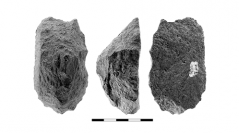

 Comptes Rendus Palevol
17 (3) - Pages 201-219
Comptes Rendus Palevol
17 (3) - Pages 201-219Heavy-duty scrapers are documented as a specific morphotype in ancient African and Eurasian toolkits from the Oldowan into the Acheulian. They are characterized by a flat platform perpendicularly oriented to a carinated edge. The convex surface of that edge displays semi-peripheral, unidirectional removals associated with steep retouch and/or crush marks. This morphotype has been described from numerous sites covering a long temporal scale and are diversely referred to in French as “rostro-carénés” or “nucléus-racloirs” and in English as “massive scrapers”, “core scrapers”, “large scrapers”, or “heavy end-scrapers”. Morpho-technological definitions and interpretations are reviewed to track the origin and evolution of heavy-duty scrapers over time and space. Results show that tools referred to as heavy-duty scrapers were made on thick cobbles during the Oldowan, and later, at the onset of the Acheulian, on Large Flakes, while smaller-sized items in Late Acheulian sites assume end-scraper morphologies. But should all of these tools really be grouped under a single denomination? Experimental work explores whether heavy-duty scrapers are the result of knapping processes, or if their morphology could be derived from other kinds of activities. Chronological continuity of the attributes specific to heavy-duty scrapers points to their role in ancient toolkits, suggesting that these scarce but ubiquitous primitive implements are, on equal footing with chopper-cores, one of the oldest morphotypes in the world.
Heavy-duty scraper, Oldowan, Technology, Typology, Acheulian, Rostro-caréné, Stone tools